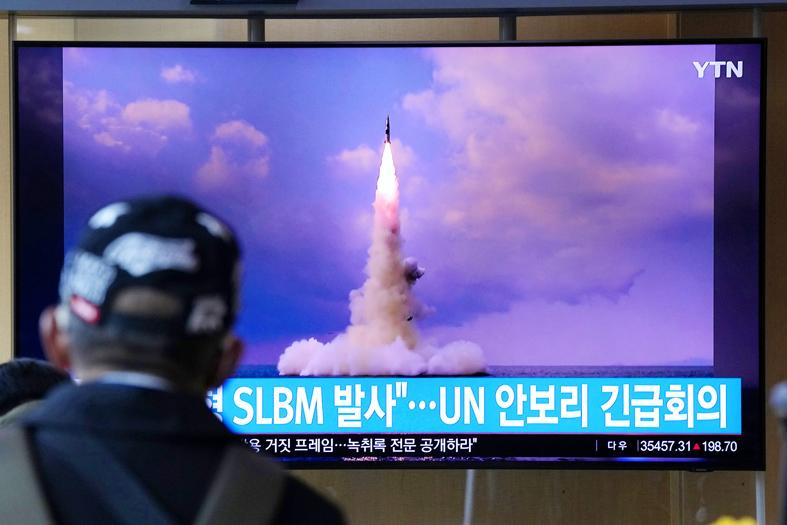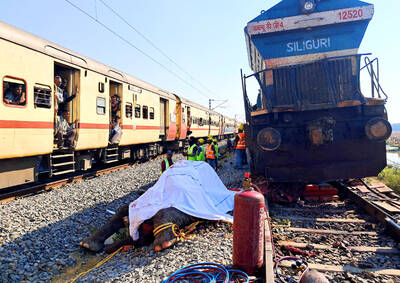North Korea test-fired a new, smaller ballistic missile from a submarine, state media said yesterday, a move that analysts said could be aimed at more quickly fielding an operational missile submarine.
The statement from state media came a day after South Korea’s military reported that it believed North Korea had fired a submarine-launched ballistic missile (SLBM) off its east coast, the latest in a string of North Korean missile tests.
Washington urged North Korea to refrain from further “provocations,” with White House spokeswoman Jen Psaki on Tuesday saying that the US remained open to engaging diplomatically with the North over its weapons programs.

Photo: AP
Pyongyang has so far rejected those overtures, accusing the US and South Korea of talking diplomacy while ratcheting up tensions with their own military activities.
South Korean Minister of Foreign Affairs Chung Eui-yong yesterday called for Washington to ease sanctions if the North returns to talks.
“Action must be taken as soon as possible to stop North Korea from further developing nuclear and missile capability,” he told the South Korean parliament. “I think considering relaxing sanctions can surely be an option.”
The US and the UK planned to raise the North’s latest test at a UN Security Council meeting yesterday, diplomats said.
The “new-type” SLBM was launched from the same submarine used in a 2016 test of an older SLBM, the North’s Korean Central News Agency (KCNA) said.
North Korea has a large fleet of aging submarines, but has yet to deploy operational ballistic missile submarines beyond the experimental Gorae-class boat used in the tests.
Photographs released by KCNA appeared to show a thinner, smaller missile than North Korea’s earlier SLBM designs, and could be a previously unseen model first showcased at a defense exhibition in Pyongyang last week.
A smaller SLBM could mean more missiles stored on a single submarine, although with a shorter range, potentially putting nuclear-armed North Korea closer to fielding an operational ballistic missile submarine (SSB).
“Though a smaller North Korea SLBM design could enable more missiles per boat, it could also enable smaller less challenging SSB designs, including easier integration/conversion on pre-existing submarines,” Joseph Dempsey, a defense researcher at the International Institute for Strategic Studies in London, wrote on Twitter.
Still, the development was expected to have only a limited effect on Pyongyang’s arsenal until it made more progress on a larger submarine that has been seen under construction.
“It just means they’re trying to diversify their submarine launch options,” said Dave Schmerler, a senior research associate at the James Martin Center for Nonproliferation Studies in California. “It’s an interesting development, but with only one submarine in the water that can launch notionally one or two of these it doesn’t change much.”
Kim Dong-yup, a former South Korean navy officer who teaches at Seoul’s Kyungnam University, said that the missile could be an advanced version of the KN-23, a short-range ballistic missile first tested in 2019, citing its range, visual resemblance and stated guidance technologies.
KCNA said that the new SLBM featured advanced capabilities including “flank mobility and gliding skip mobility.”
The SLBM “will greatly contribute to putting the defense technology of the country on a high level and to enhancing the underwater operational capability of our navy,” KCNA added.
Schmerler said that “glide skip” is a way to change a missile’s trajectory to make it harder to track and intercept.

The Burmese junta has said that detained former leader Aung San Suu Kyi is “in good health,” a day after her son said he has received little information about the 80-year-old’s condition and fears she could die without him knowing. In an interview in Tokyo earlier this week, Kim Aris said he had not heard from his mother in years and believes she is being held incommunicado in the capital, Naypyidaw. Aung San Suu Kyi, a Nobel Peace Prize laureate, was detained after a 2021 military coup that ousted her elected civilian government and sparked a civil war. She is serving a

REVENGE: Trump said he had the support of the Syrian government for the strikes, which took place in response to an Islamic State attack on US soldiers last week The US launched large-scale airstrikes on more than 70 targets across Syria, the Pentagon said on Friday, fulfilling US President Donald Trump’s vow to strike back after the killing of two US soldiers. “This is not the beginning of a war — it is a declaration of vengeance,” US Secretary of Defense Pete Hegseth wrote on social media. “Today, we hunted and we killed our enemies. Lots of them. And we will continue.” The US Central Command said that fighter jets, attack helicopters and artillery targeted ISIS infrastructure and weapon sites. “All terrorists who are evil enough to attack Americans are hereby warned

Seven wild Asiatic elephants were killed and a calf was injured when a high-speed passenger train collided with a herd crossing the tracks in India’s northeastern state of Assam early yesterday, local authorities said. The train driver spotted the herd of about 100 elephants and used the emergency brakes, but the train still hit some of the animals, Indian Railways spokesman Kapinjal Kishore Sharma told reporters. Five train coaches and the engine derailed following the impact, but there were no human casualties, Sharma said. Veterinarians carried out autopsies on the dead elephants, which were to be buried later in the day. The accident site

‘NO AMNESTY’: Tens of thousands of people joined the rally against a bill that would slash the former president’s prison term; President Lula has said he would veto the bill Tens of thousands of Brazilians on Sunday demonstrated against a bill that advanced in Congress this week that would reduce the time former president Jair Bolsonaro spends behind bars following his sentence of more than 27 years for attempting a coup. Protests took place in the capital, Brasilia, and in other major cities across the nation, including Sao Paulo, Florianopolis, Salvador and Recife. On Copacabana’s boardwalk in Rio de Janeiro, crowds composed of left-wing voters chanted “No amnesty” and “Out with Hugo Motta,” a reference to the speaker of the lower house, which approved the bill on Wednesday last week. It is